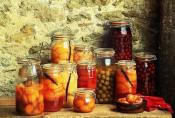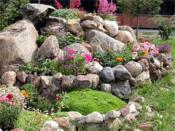Search
Login
Recommended
Pruning a garden in spring, pruning shrubs
The key to a rich harvest of berries - timely measures to protect shrubs from pests and their proper pruning. Shrubs in spring require the most active care - chemical treatment carried out during this period will protect the plant from damage by harmful microorganisms and fungi, protect it from attack by harmful insects. Modern combined protective equipment helps to minimize the number of treatments for shrubs, in addition, they are able to deal with several types of pests. Plant treatment should be carried out at the indicated time, with appropriately prepared solutions, so as not to harm the bark of plants, it is best to carry out spraying activities on cloudy days.
Content:
- Proper pruning of shrubs in the spring is the key to high productivity video
- Spring currant pruning video
- Gooseberry pruning in spring video
- Spring honeysuckle pruning video
- Pruning raspberries in spring and autumn video
Proper pruning of shrubs in the spring is the key to high productivity
Equally important is the proper pruning of plants. Timely removal of rotten and frost-damaged branches is very important for the plant, too old branches are also subject to removal, the potential of which has already been exhausted in terms of yield. In addition, pruning to form a bush will make each twig more accessible to sunlight, the energy of the sun received by the berries will make them sweeter and more fragrant.

Only here are the rules of the pattern for each type of fruitful shrubs, in order to get a good harvest on a properly formed bush you will need to know the growth characteristics of the fruiting conditions of each crop that grows in your garden.
Spring currant pruning
Pruning currant bushes is carried out precisely in the spring.

Of great importance for the bush is the number of branches formed in the last growing season - they are most suitable for fruiting. A significant number of berries are usually tied in thirty-forty centimeter increments of the first and second branches.
High yields can also be obtained on four- or five-year-old branches. Older branches gradually lose their ability to bear fruit and give growth.
The correct bush of currant should have about 15-20 branches and be formed as follows:
- 3 or 4 of its branches should be annual,
- the same number of branches should be the second year of life, etc.

Maintain a bush in this state can be up to 10-12 years. The process of forming the bush begins at the age of 1 year, when it already has from the spirit to four branches. On each branch should leave 3 or four well-developing buds.
If the bush gave a lot of nulls, i.e. sprouting branches from the soil, you should evaluate each of them and leave 3-4 the strongest ones, the rest should be removed very low using garden scissors.
Pruning neglected bushes is carried out in several stages, gradual removal will prevent a violation of the development of the aerial and root parts of the plant. First of all, it is required to remove the oldest, 5-6 year old branches, they can be distinguished by the largest volume and shortened growths. The following year, the oldest of the remaining branches are removed. Removal is carried out completely; hemp is also recommended to be eliminated. Slices are performed on the very border with the soil.

From the foregoing, we can conclude:
- properly trimmed currant bush should consist of 2-4 branches of different ages,
- annually in the spring, damaged branches should be removed, and branches whose age does not allow them to actively bear fruit.
Gooseberry pruning in spring
This culture is also quite popular and is often grown in garden plots.

The fruiting of the plant begins early, almost every year its bushes delight with a rich harvest of berries containing a large amount of vitamin C, calcium, iron, phosphorus, pectin substances. One important factor in regulating fruiting is the spring pruning of gooseberries.
Trimming gooseberries is a must - proper care will help regulate the processes of growth and fruiting, not only of the whole plant, but also of its individual parts. Proper care will allow you to grow currant and gooseberry bushes in one place for up to 25-30 years, which is sometimes very important in the conditions of a limited summer cottage area.

It is recommended to renew gooseberry bushes due to root shoots developing from sleeping or underground buds. Plant formation is started immediately after planting, it is usually made in the fall, pruning is done in the spring, until the first buds bloom.
Immediately after planting, the branches are cut, leaving 3-4 developing buds. Such pruning will lead to increased growth of shoots on two-year branches, as well as the formation of new root shoots. Depending on the gooseberry variety, such shoots may form 3-5 pieces, or even more. Shoots should be evaluated and only the strongest should be left. You can remove zero shoots in the fall, but if for some reason you did not do this, then with the onset of spring it is necessary to cut them off near the surface. 3-4 young annual shoots should remain on a young bush.
It should be remembered that the main crop on the bush will be formed on the branches of the second branching order, i.e. a very important point will be the correct pruning of gooseberries in the second year after planting.
The process will be as follows:
- to enhance the lateral branching process, shorten the growth,
- new basal shoots are removed, leaving 3-4 of the strongest of them.
On the zero branches left last year and shortened in the spring, strong first-order branches will appear in the summer. In subsequent years, throughout the life of the plant, it will be necessary to produce spring pruning of gooseberries according to the above scheme. Starting from the age of eight, each of the three oldest branches should be removed every spring, instead of them, leave and grow 3 new zero shoots.

Trimming gooseberries in spring must be done - the bush should have a small number of branches, a very overgrown dense bush will not yield a good crop. The optimal number of branches for a gooseberry bush is 14-18 shoots of different ages, depending on the variety. Each of the fruiting branches should allow light and air to freely penetrate to the center of the bush.
Lack of proper care and pruning will lead to rapid aging of the bushes, weakening of annual growth.
Spring honeysuckle pruning
Amateur gardeners are happy to grow this beautiful plant as an ornamental. In the middle lane in the open ground, you can grow about 200 varieties of this amazing plant. Some types of honeysuckle are grown in orchards to produce edible berries. It is advisable to prune them in the fall, but if this was not possible, be sure to take the time to care for the bush in early spring.

When planting honeysuckle bushes, it should be borne in mind that under natural conditions, the height of the bush can be about 2.5 m, its diameter may be the same. We should not forget that the plant is very photophilous. Bushes grow slowly, so the first couple of years they probably will not need to be cut. You should observe the increase in the volume of the bush, if the process is uniform, then pruning can be delayed for another couple of years. But miss the moment the onset of thickening is also not desirable. To destroy the bush should be the removal of zero branches coming from the ground.

If it becomes noticeable that the branches are too thick, you will need to remove the weakest ones. If the bush is not thinned out in a timely manner - it will suffer from a lack of light, not annual shoots but older branches, which form the basis of the bush, may suffer. It should be noted that honeysuckle is very prone to thickening. It can be caused not only by zero branches, but also by actively formed tops. They appear in most cases on branches that, by age or condition, have stopped growing shoots from the buds at the top.

Performing annual pruning of the honeysuckle crown, it is necessary to remove not only dry and broken shoots, but also all weak and short shoots - you will definitely not be able to get a good crop from them. Since the fruits are more often placed on the annual branches, when pruning the honeysuckle in spring, the shoots that appeared the previous summer should not be shortened. It is best to remove part of the branches inside the crown, thereby ensuring good illumination of the bush.
With age, the honeysuckle bush will require rejuvenation. Usually this happens in the second ten years.
Such pruning consists in strong thinning. Next, remove branches that have stopped growing. All drying branches should be trimmed before healthy living tissue appears. If the wounds on the branches are large, they should be painted over or glossed over with garden varieties.
You can save a fully aged plant in the following way:
- all its branches should be cut off near the ground,
- waiting for the young growth to begin to form a new bush.
Pruning raspberries in spring and autumn
The aerial part of raspberries is annual and biennial shoots. Only two-year-olds bear fruit, after which they die. Substitution shoots are formed from buds found on rhizomes, especially active growth of substitution shoots is observed in the first season after planting bushes. On young shoots, buds are laid that are intended for next year's harvest.

This biological feature of the plant should be considered when pruning. Carry out the removal of sprouting branches in early autumn, at the end of fruiting. All shoots from which the crop was received are subject to removal.

Pruning is done very low, at ground level, and broken or weak branches are also removed.
To maintain normal illumination and permissible thickening of the planting, it is enough to leave from 8 to 12 young shoots on the running meter of plantings. All others are subject to pruning, removal from the site and burning.
Pruning raspberries in the spring consists in shortening the tops of the shoots, such actions can reduce the growth rate of shoots and more fully provide flower buds with nutrients and moisture. An important point - in this case, the crop can be harvested in the middle of summer, when the weather allows the berries to fully ripen.

Experienced gardeners, wanting to extend the fruiting period of raspberries, resort to this trick: pruning raspberries in the spring produce at different heights, some bushes are lower, others are higher. At the same time, they are divided into three parts and cut:
- 1st part - 10-12 cm,
- 2nd - half the length,
- The third part is cut off, leaving only 10-15 cm of height above ground level.
Harvest raspberries with this pruning can be enjoyed from mid-summer to late autumn.
Pruning raspberries should be made taking into account whether the bush belongs to fruiting varieties once or several times a season, i.e. repaired. If a variety bears fruit once, the pruning technique described above is applied to it:
- harvested shoots are harvested in the fall,
- selectively remove annual shoots,
- sanitary pruning is also performed.
If the variety is referred to as maintenance, then you can get a crop from the upper buds of the shoots of the first year of replacement. Then, after the death of part of the shoot, the kidneys will form on it under the fruits of the next year. pruning repair bushes produced by several methods. The first is in the likeness of how ordinary raspberries are cut. The second is to remove the entire aerial part of the plant. All garbage is removed from the site, the soil is loosened, watered and covered with mulch. Suitable time for such work is October-early November, depending on weather conditions. In spring there will be an active forcing of young shoots that can give a wonderful harvest.

This method of pruning raspberries completely eliminates the possibility of frostbite of fruit buds and shoots of substitution. In addition, the material on which diseases and pests accumulate will disappear - there simply will not be an aerial part of plants.
If there is a desire to get a super-early harvest - do not forget to cover the raspberry plantings with black plastic wrap in early spring, in which case the growing season will begin a few months earlier.
Pruning shrubs, especially if it is done according to all the rules, is difficult to attribute to easy occupations. But only one who carefully fulfills all conditions throughout the summer and autumn will receive fragrant, rich in vitamins, sweet and juicy berries.





